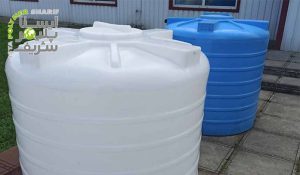Water tanks have long been used for water storage. Various types of tanks are used for different applications, including drinking water, agriculture, and firefighting. Choosing among types of water storage tanks and selecting the appropriate materials for constructing a tank based on its application and overall design of the drinking water tank is crucial. Considering the importance of human health and environmental preservation, making the right choice of tanks can help solve problems in developing countries. This article examines the different types of water storage tanks to aid in making an informed choice.
Types of Water Storage Tanks
Cement Tanks
Cement tanks are a type of water storage tanks that have been around for a long time. These tanks face significant issues with cracking and leaking of the liquid inside. They are also prone to damage during earthquakes. Economically, they are less desirable compared to plastic tanks for purchase and installation.
Fiberglass Tanks
Fiberglass tanks are durable, corrosion-resistant, and heat-resistant. Their resistance to heat is one of their advantages.
Welded Steel Tanks
These tanks are very durable and are made from stainless steel for industrial applications.
Polymeric Tanks
Polymeric tanks, primarily made from polyolefins like polyethylene and polypropylene, entered the market after cement tanks. They have a longer useful life. The majority of polymer used in polyethylene tanks does not corrode and does not rust. It is important to note that phenolic, PET, and cross-linked polyethylene are also used for water tanks. The ease of transport due to the light weight of the polymer has attracted both industry professionals and users. These tanks, like cement tanks, do not leak, and sealing is not an issue. The flexibility of polyethylene makes it resistant to earthquakes. Another important factor is economic efficiency, as they are more favorable compared to cement or concrete tanks.
Categorization of Water Storage Tanks
Water tanks can be categorized from several perspectives:
For storing drinking water in dark environments, single-layer tanks can be used. In environments with light, double-layer tanks, with a clear inner layer and a colored outer layer, are used to prevent light from reaching the liquid inside. In bright environments and areas prone to algae growth, triple-layer tanks are used, as the middle black layer prevents UV rays and chemical reactions with the liquid. For cases requiring adequate strength and reduced heat transfer from the tank walls (in very hot environments or where freezing is a concern), foam-filled tanks, either double or triple-layered, can be used.
What to Consider When Choosing a Water Storage Tank?
Before selecting a type of water storage tank, special attention should be paid to the volume and the site where the tank will be installed. Ensuring the structural integrity of the tank is crucial. In other words, the base of the tank should be smooth. For drinking water storage or firefighting applications, a three-layer water tank should be used. In areas with height constraints, horizontal water storage tanks can be used. If minimizing occupied space is a priority, options include under-stair tanks, cubic tanks, and vertical tanks as well.






